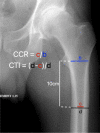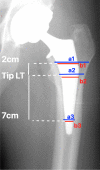No significant differences in 60-day postoperative complication rates between conventional and shortened stems
- PMID: 38153605
- PMCID: PMC10754806
- DOI: 10.1186/s40634-023-00696-8
No significant differences in 60-day postoperative complication rates between conventional and shortened stems
Abstract
Purpose: To compare 60-day complication rates, radiographic outcomes, and clinical outcomes following primary THA with conventional versus shortened stems, in a large cohort study.
Methods: The authors reviewed a consecutive series of 800 primary THAs, of which 781 met the inclusion/exclusion criteria: 395 received a conventional stem and 386 received a shortened stem. Intraoperative and postoperative complications were noted. Radiographic and clinical assessments were performed preoperatively and 60 days after surgery.
Results: Compared to conventional stems, shortened stems had significantly less intraoperative complications (2.8% vs 0.3%, p = 0.006), but no significant differences in complications that did not require reoperation (1.0% vs 1.3%, p = 0.620), complications that required reoperation without stem revision (2.0% vs 1.0%, p = 0.384), and complications that required stem revision (0.5% vs 0.5%, p = 1.000). Four hips (two from each group) required stem revision and were thus excluded from 60-day assessment. There were no significant differences between groups in subsidence ≥ 3 mm (1.0% vs 0.5%, p = 0.686), alignment (90.3%vs 86.7%, p = 0.192), net change in offset (within 3 mm, 32.3% vs 30.5%, p = 0.097), and limb length discrepancy (3.0 ± 2.6 mm vs 2.9 ± 2.4 mm, p = 0.695). Compared to conventional stems, shortened stems had significantly better preoperative mHHS (56.5 ± 18.5 vs 64.5 ± 13.5, p < 0.001), and significantly lower net improvement in mHHS (29.9 ± 17.1 vs 24.4 ± 15.0, p < 0.001), but no significant differences in postoperative mHHS (87.3 ± 11.9 vs 89.4 ± 9.6, p = 0.109).
Conclusions: There were no significant differences between conventional and shortened stems in terms of postoperative complication rates, radiographic outcomes, and postoperative mHHS. However, patients implanted with shortened stems had less intraoperative complications, but lower net improvement in mHHS.
Level of evidence: Level IV, Retrospective comparative cohort study.
Keywords: Radiographic outcomes; Short stems; THA; Total hip arthroplasty; Total hip replacement.
© 2023. The Author(s).
Conflict of interest statement
NB received fees from Dedienne Santé (France) for support in study design and manuscript preparation. All other authors declare no conflict of interests.
Figures



Similar articles
-
Satisfactory clinical and radiographic outcomes following revision total hip arthroplasty by direct anterior approach using primary femoral stems at 2-8 years of follow-up.Arch Orthop Trauma Surg. 2023 Oct;143(10):6393-6402. doi: 10.1007/s00402-023-04838-6. Epub 2023 Mar 19. Arch Orthop Trauma Surg. 2023. PMID: 36935414
-
Comparative outcomes between collared versus collarless and short versus long stem of direct anterior approach total hip arthroplasty: a systematic review and indirect meta-analysis.Eur J Orthop Surg Traumatol. 2019 Dec;29(8):1693-1704. doi: 10.1007/s00590-019-02516-1. Epub 2019 Jul 30. Eur J Orthop Surg Traumatol. 2019. PMID: 31363848
-
Effect of femoral stem surface coating on clinical and radiographic outcomes of cementless primary total hip arthroplasty: a patient-matched retrospective study.Int Orthop. 2023 Jan;47(1):165-174. doi: 10.1007/s00264-022-05629-1. Epub 2022 Nov 17. Int Orthop. 2023. PMID: 36385185 Free PMC article.
-
High Risk of Neck-liner Impingement and Notching Observed with Thick Femoral Neck Implants in Ceramic-on-ceramic THA.Clin Orthop Relat Res. 2022 Apr 1;480(4):690-699. doi: 10.1097/CORR.0000000000002022. Clin Orthop Relat Res. 2022. PMID: 34699410 Free PMC article.
-
Low Reinfection Rates But a High Rate of Complications in THA for Infection Sequelae in Childhood: A Systematic Review.Clin Orthop Relat Res. 2021 May 1;479(5):1094-1108. doi: 10.1097/CORR.0000000000001607. Clin Orthop Relat Res. 2021. PMID: 33617159 Free PMC article.
Cited by
-
Reduced periprosthetic fracture rate for a cemented anatomical versus a tapered polished stem in hip arthroplasty: A 6-year follow-up of a prospective observational cohort study.J Exp Orthop. 2025 Apr 16;12(2):e70243. doi: 10.1002/jeo2.70243. eCollection 2025 Apr. J Exp Orthop. 2025. PMID: 40242189 Free PMC article.
-
Does the use of shortened stems reduce early femoral complications in total hip arthroplasty using the direct anterior approach?Arthroplasty. 2025 Jul 1;7(1):32. doi: 10.1186/s42836-025-00317-y. Arthroplasty. 2025. PMID: 40588744 Free PMC article.
-
Epidemiology of hospitalization for hip replacement: Which implications for orthopaedics and rehabilitation? A 15-year longitudinal study.J Exp Orthop. 2025 Jun 1;12(2):e70298. doi: 10.1002/jeo2.70298. eCollection 2025 Apr. J Exp Orthop. 2025. PMID: 40453477 Free PMC article.
-
Association of spinopelvic mobility and osteosarcopenia with total hip arthroplasty outcomes.J Exp Orthop. 2025 Aug 5;12(3):e70395. doi: 10.1002/jeo2.70395. eCollection 2025 Jul. J Exp Orthop. 2025. PMID: 40766803 Free PMC article.
-
The rise of hip research in the Journal of Experimental Orthopedics.J Exp Orthop. 2025 Apr 13;12(2):e70233. doi: 10.1002/jeo2.70233. eCollection 2025 Apr. J Exp Orthop. 2025. PMID: 40226535 Free PMC article. No abstract available.
References
-
- Beck M, Brand C, Christen B, Zdravkovic V (2021) Swiss National Hip & Knee Joint Registry - Report 2021 - Annual Report of the SIRIS Registry, Hip & Knee, 2012 – 2020.
LinkOut - more resources
Full Text Sources
Research Materials
Miscellaneous

